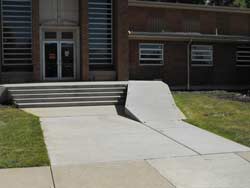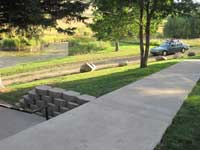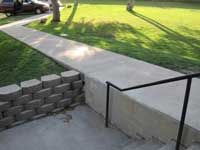Public Access Ramps

What were they thinking? This short, two-ended ramp provides access to the door of the building directly behind it. However. If the viewer looks closely, the only access onto the sidewalk, provided by an extremely short piece of concrete poured in the gutter in front of the sidewalk itself, has been blocked by the new construction with no pedestrian cut provided for wheelchair access to the sidewalk ANYWHERE on the block. And we know that because we walked the entire block. Not quite sure how wheelchair users are supposed to access the sidewalk, the ramp, nor the building.

No Passing Zone. This is one of the few ramps I've seen that comes close to the appropriate 12:1 pitched slope while providing access to a second story entrance. However. Narrow with tight turns, this ramp is best suited to individuals using a cane as their primary mobility aide. Walkers and adult sized wheelchairs would have a difficult time squeezing between the railing and the concrete wall going up the ramp way and navigating the tight hairpin turns. Vehicle access in the parking stall is also limited to the driver's side only with a narrow, and angled, pedestrian cut onto the sidewalk provided at the rear of the vehicle. This isn't a building we could access.

Use With Caution This ramp is part of a remodel project. Initial access to the ramp itself is very narrow but the ramp itself does widen toward the top end of the slope. Landing is adequate provided the building doors are closed. There is very little maneuvering room between the doorway and the stairs themselves, making this a hazard to the mobility aid user. Provisions have been made in the concrete for a railing system but only along the ramp proper. This one could be dangerous.


Use With Caution!
Another well intentioned ramp not given much thought. This ramp is a direct access route to a public meeting space in a nearby State Park. This building and the adjacent grassy area are used for overnight camping and other public events. It is important to note 2 very glaring safety hazards.
- The current ramp does NOT have railing. Stair railing does not extend the entire length of the opening making this a marked safety hazard for ALL individuals using this ramp. Unsteady individuals using a cane or walker and needing the extra security of a railing will be unable to use this. This is especially dangerous at night when poor lighting hides that hazard waiting at the edge of the ramp and the base of the adjacent stairs. One false step and you'll find yourself at the bottom. A 3ft. drop onto solid concrete.
- Once past the concrete pit at the base of the stairs ramp users will find themselves on an open slope with zero curbing and no railing. Any individual may come off the edge of this walkway/ramp at any time and find themselves on a relatively steep grassy downward slope rolling towards a gravel road and a pond beyond. This is especially hazardous when wet or icy. Individuals using ANY type of mobility aide may find themselves actually tumbling down this slope. This is an extremely dangerous area and shouldn't be used.





